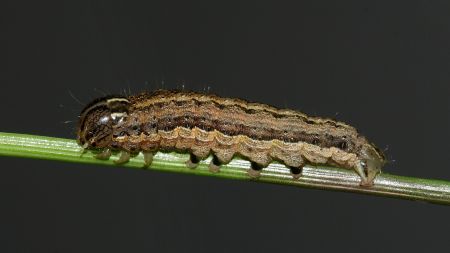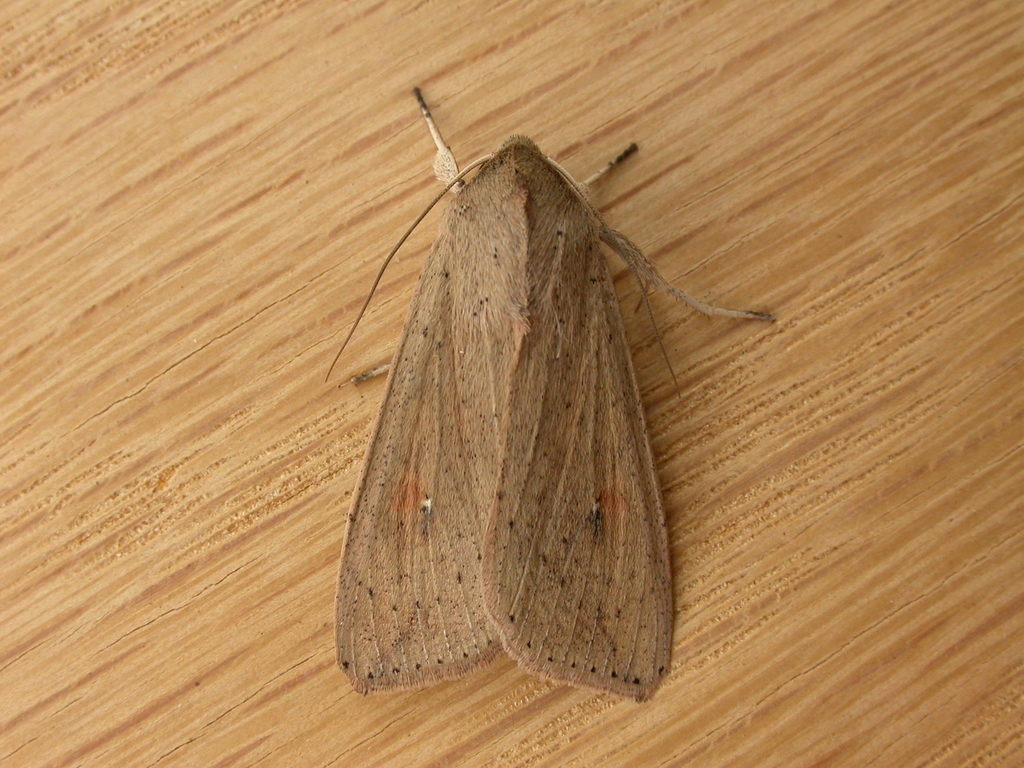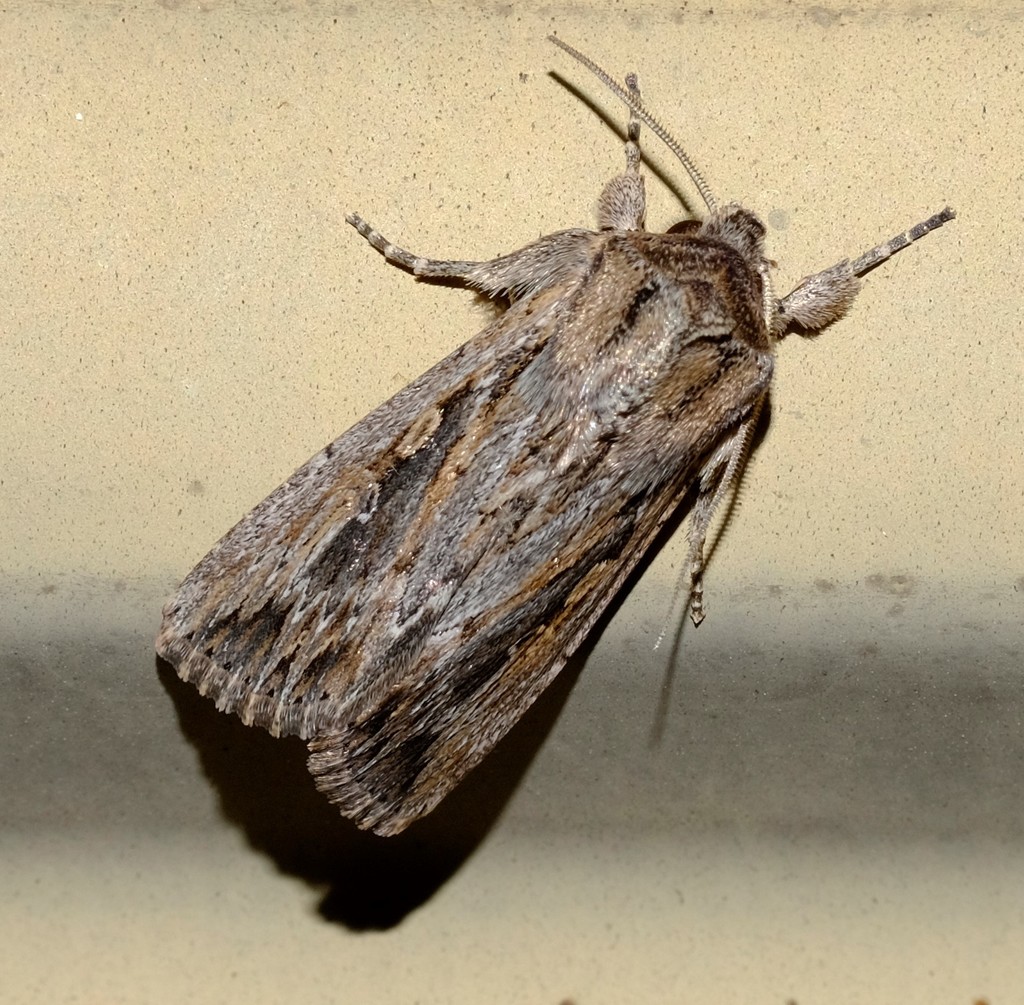Armyworms
Armyworms are caterpillar pests of grass pastures and cereal crops.
Armyworms mostly feed on leaves, but under certain circumstances will feed on the seed stem, resulting in head loss. The change in feeding habit is caused by depletion of green leaf material or crowding. In the unusual event of extreme food depletion and crowding, they will 'march' out of crops and pastures in search of food, which gives them the name 'armyworm'.
Description
There are 3 common species of native armyworm found in southern Australia:
- common armyworm (Mythimna convecta)
- southern armyworm (Persectania ewingii)
- inland armyworm (Persectania dyscrita)
Note that the non-native fall armyworm(Spodoptera frugiperda) arrived in Queensland in February 2020 and has subsequently been found in the Northern Territory, Western Australia, New South Wales and, as of December 2020, in Victoria. You can read more information on fall armyworm.
Caterpillars
The caterpillars of the 3 species are similar in appearance, identifiable by 3 parallel white or cream stripes along their body, particularly apparent in larvae that are longer than 10 mm (Figure 1).
They grow from about 2 mm to 40 mm in length, have no obvious hairs, are smooth to touch and curl up when disturbed.

Adults
Moths are often seen flying on warm, humid nights. They are medium-sized, with a wingspan of 30mm to 40mm.
Each species has a characteristic colour and wing markings:
- The Common armyworm has forewings that are dull yellow to red–brown, speckled with tiny black dots and a small white dot near the centre (Figure 2).
- The southern armyworm has grey–brown to red–brown forewings with white zig-zag markings on the outer tips and a pointed white ‘dagger’ in the middle of the forewing. The hind wings are dark grey (Figure 3).
- The inland armyworm is similar to the southern armyworm, except the white ‘dagger’ in the centre of the forewing is divided into 2 discrete light ellipses that almost touch. The hind wings are pale grey (Figure 4).



Pupae
Pupae of all 3 species are about 20 mm long, shiny brown and are found under clods or within cracks in the soil.
Feeding damage
The young larvae feed initially from the leaf surface of pasture grasses and cereals. As the winter and spring progress and the larvae grow, they chew ‘scallop’ marks from the leaf edges. This becomes increasingly evident by mid to late winter.
By the end of winter or early spring, the larvae are reaching full growth and maximum food consumption. It is this stage that farmers most frequently notice, as complete leaves and tillers may be consumed or removed from the plant.
Damaging infestations or outbreaks occur in 3 situations:
- In winter when young tillering cereals are attacked and can be completely defoliated. The caterpillars may come from the standing stubble from the previous year's cereal crop in which the eggs are laid, or from neighbouring pastures that dry out, resulting in the resident armyworms being forced to march into the crop.
- In spring or early summer when crops start ripening and seed heads may be lopped.
- In early summer when grass pastures are cut for hay, particularly in Gippsland.
The most damage is caused in ripening crops when the foliage dries off. The armyworms then begin to eat any green areas that remain.
In cereals, the last section of the stem to dry out is usually just below the seed head. Armyworms, particularly the older ones, that chew at this vulnerable spot cause lopping of the heads and can devastate a crop nearing maturity in one or 2 nights.
Generally, the larger the armyworm, the greater the damage. In wheat and barley, whole heads are severed, while in oats individual grains are bitten off below the glumes.
The crops affected include all Gramineae crops, including cereals, grassy pastures, corn and maize.
Outbreaks
Major outbreaks occasionally occur across Victoria, particularly after periods of drought.
There are many factors that can lead to an outbreak, including:
- large invasions of moths that have bred in arid regions of New South Wales, South Australia or western Queensland
- significantly less mortality of eggs and young caterpillars
- droughts, which can trigger outbreaks because of the negative effects they have on the natural enemies of armyworms – these predators and parasites recover much more slowly from a drought than armyworms can.
The role of stubble retention
Winter outbreaks are most common in crops under conditions of stubble retention and minimum cultivation. This is because:
- most eggs would not be laid in a crop in the absence of stubble
- stubble and undisturbed soil also provide a continuous habitat for a range of natural enemies, which help to control many pest problems.
The direct and indirect benefits of these conservation tillage practices far outweigh their costs, including the occasional outbreak of armyworm.
Seasonal activity
It is unusual for crops to be invaded 2 seasons in a row — a heavy infestation in one year rarely results in a further problem in the following season.
Common armyworm
The common armyworm is the more usual pest in spring and early summer. This species spends its winter in the warmer regions of northern Australia, and the subsequent generation of moths migrates south in early spring.
As crops and pastures start drying, the larvae are usually large enough to lop off tillers and stems bearing the seed heads — this accounts for most economic loss caused by armyworms.
The moths that emerge from the spring generation migrate to other areas where green pastures or crops permit a new generation of egg-laying.
Southern and inland armyworm
Southern and inland armyworm caterpillars can be found in autumn and winter, often in relatively high densities, throughout the grasslands and crops of south-eastern Australia.
There are 2 generations per year. Most eggs are either laid in autumn, often immediately after rain, or in late winter.
The hatch of the autumn generation is synchronised with the emergence of autumn pastures and crops. The young caterpillars cause little damage while feeding on leaf surfaces, while the older larvae can defoliate the plant.
Moths of the southern and inland armyworm appear not to lay eggs after a spring emergence. There has been little research on the biology of these 2 species, but field observations suggest they have a winter habit and that larvae do not usually survive the warmer temperatures of the late spring and summer periods.
The moths reappear in the autumn, particularly at about the time of the first autumn rains. It is at this stage that they start laying eggs in the dry grass and stubble from the previous pasture or cereal crop.
Lifecycle
Armyworm eggs are laid in batches of about 5 to 30, glued together in the hidden, twisted crevices of dried grasses, straw and stubble or sometimes in seed heads.
The eggs can take 6 to 20 days to hatch, depending on local temperatures. The young larvae, which are about 2 mm to 3 mm in length, can be dispersed by wind a few metres away from the egg-laying sites on fine silken threads.
There are usually 6 stages (instars) of caterpillar growth and the skin is shed after each. Older caterpillars crawl around at night and may move up and down plants regularly. They spend the day curled up at the base of the plant under clods of soil or in the plant crown. It is the older and larger larvae that cause all the damage to crops.
The larvae soon tunnel into the soil to pupate. The mature caterpillars pupate in the surface of the soil at the base of the plant. The adult moth emerges at least 4 to 6 weeks (possibly more) after pupation and migrates away from the region.
Detection
Signs of the presence of armyworms include:
- chewing/leaf scalloping along the leaf margins.
- caterpillar excreta or ‘frass’, which collects on leaves or at the base of the plant – these appear as green or yellow cylindrical pellets 1 mm to 2 mm long
- cereal heads or oat grains on the ground – oat grains may be attached to a small piece of stalk (1 mm to 2 mm), whereas wind-removed grains are not, and barley heads may be severed completely or hang from the plant by a small piece of stalk.
Early detection is essential, particularly when cereals and pasture seed or hay crops are at the late ripening stage.
Although accurate estimates of caterpillar densities require considerable effort, the cost saving is worthwhile.
Sampling
Sampling can be achieved by:
- using a sweep-net or bucket
- visually searching the ground or crop for either caterpillars or damage symptoms.
Sweep-net or bucket method
The sweep-net or bucket method provides a rapid and approximate estimate of infestation size. The net or bucket should be swept across the crop in 180o arcs several times (preferably 100 times) at different sites within the crop to give an indication of density and spread.
Armyworms are most active at night, so sweeping will be most effective at dusk.
Average catches of more than 5 to 10 per 100 sweeps suggest that further searches on the ground are needed to determine approximate densities.
Ground or crop searching
When ground sampling, it is necessary to do at least 10 ‘spot checks’ in the crop, counting the number of caterpillars within a square metre.
Most farmers fail to detect armyworms until the larvae are almost fully grown and 10% to 20% damage may result. The earlier the detection, the less the damage. The young larvae (up to 8 mm) cause very little damage, but are more difficult to find.
The critical time to look for armyworms is the last 3 to 4 weeks before harvest.
Distinguishing armyworm larvae from other pests
Armyworms can be distinguished from other caterpillar pests that may be found in the same place by 3 pale stripes that run the length of the body. These stay constant no matter the variation in the colour of the body.
Other species of caterpillar that might be confused with armyworms include the following:
- Loopers (tobacco looper or brown pasture looper) walk with a distinct looping action and have 1 or 2 pairs of abdominal prolegs – armyworms have 4 pairs, and when longer than 10mm do not walk with a looping action.
- Budworm larvae have prominent but sparse hairs and bumps on their skin and anthelid larvae are covered in hairs – armyworms are smooth-bodied with no obvious hairs.
- Cabbage moth larvae wriggle vigorously when disturbed – armyworms curl up into a tight ‘C’.
- Cutworm (brown or common cutworm) larvae have no obvious stripes or markings and are uniformly brown, pink or black.
Image credits
Figure 1: Agriculture Victoria.
Figures 2 and 3: David Hobern, iNaturalist CC BY
Figure 4: Peter Crowcroft, iNaturalist CC BY
Reporting an unusual plant insect pest or disease
Report any unusual plant pest or disease immediately using our online reporting form or by calling the Exotic Plant Pest Hotline on 1800 084 881. Early reporting increases the chance of effective control and eradication.
Please take multiple good quality photos of the pests or damage to include in your report where possible, as this is essential for rapid pest and disease diagnosis and response.
Your report will be responded to by an experienced staff member, who may seek more information about the detection and explain next steps.
Report online